Recent Posts
Maintaining a Safe and Clean Workspace in South Baton Rouge
7/26/2024 (Permalink)
A clean and safe workspace is essential for any business. Here are some tips to maintain it:
- Regular Cleaning: Schedule routine cleaning to keep the workspace hygienic.
- Safety Protocols: Implement and enforce safety protocols to prevent accidents.
- Pest Control: Keep pests at bay with regular inspections and treatments.
- Professional Services: Hire professional cleaning services for thorough sanitation.
SERVPRO of South Baton Rouge offers comprehensive commercial cleaning services to keep your business in top shape.
Mold Remediation After Storms and Flooding: Protecting Your Home
1/4/2024 (Permalink)
Storms and flooding can wreak havoc on our homes, leaving behind not only visible damage but also unseen threats. One of the most common and potentially dangerous consequences of water damage is mold growth. When left unattended, mold can cause various issues and structural damage. In this blog, we will explore the importance of mold remediation after storms and flooding, and how taking swift action can protect your home and safeguard your health.
Understanding the Risks of Mold After Storms and Flooding
- Explaining how excess moisture from storms and flooding creates an ideal environment for mold growth.
- Discussing the various types of mold commonly found after water damage and their potential health implications.
- Highlighting the importance of early detection and addressing mold issues promptly to prevent further damage.
The Dangers of Mold to your home
- Discussing how mold can weaken the structural integrity of your home and compromise its value.
- Emphasizing the importance of addressing mold growth to preserve the integrity of your living space.
Professional Mold Remediation Services
- Exploring the expertise and specialized equipment that professional mold remediation companies bring to the process.
- Discussing how experienced professionals can accurately assess the extent of the mold problem and develop a comprehensive remediation plan.
- Highlighting the benefits of hiring professionals, including their knowledge of effective mold removal techniques and their ability to minimize the likelihood of mold recurrence.
Steps in Mold Remediation After Storms and Flooding
Outlining the key steps involved in the mold remediation process, such as containment, air filtration, removal of affected materials, and thorough cleaning. Explain the importance of addressing the underlying cause of the mold growth, such as water intrusion or excessive moisture, to prevent future issues. Educate homeowners on the significance of proper disposal of mold-infested materials in a safe and regulated manner.
Preventive Measures to Avoid Future Mold Growth
- Providing practical tips to reduce the risk of mold growth in the future, such as maintaining proper ventilation, monitoring indoor humidity levels, and promptly addressing water leaks or damage.
- Highlighting the role of professional inspections and regular maintenance in detecting any potential mold issues before they escalate.
- Encouraging homeowners to be proactive in taking preventive measures to ensure a mold-free environment and protect their homes.
Mold growth after storms and flooding can be a significant concern for homeowners, but with prompt and professional mold remediation, the risks can be minimized. By understanding the dangers of mold to your home, and by enlisting the services of experienced professionals, such as SERVPRO of South Baton Rouge, you can safeguard your property and create a healthier living environment. Don't underestimate the importance of mold remediation after storms and flooding – take action today to protect your home and the well-being of your loved ones.
How to Remove Soot and Smoke Residue from Surfaces
12/18/2023 (Permalink)
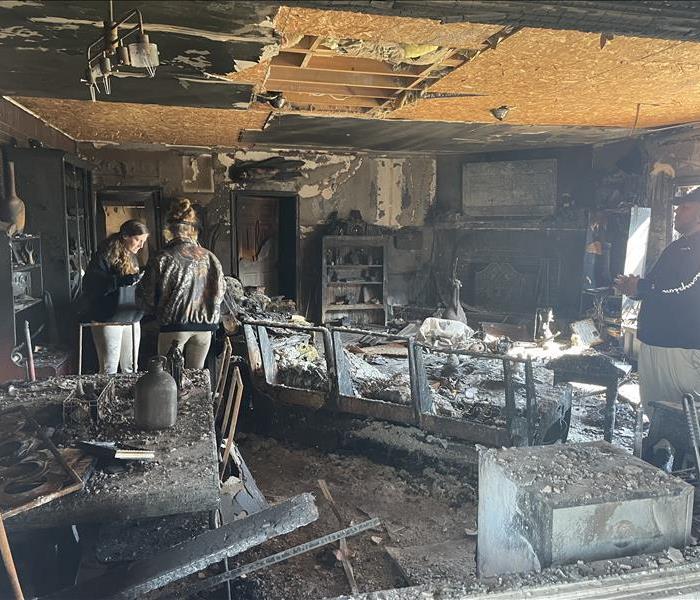 If you are unsure or dealing with extensive fire damage, it is recommended to consult with professional fire damage restoration experts.
If you are unsure or dealing with extensive fire damage, it is recommended to consult with professional fire damage restoration experts.
After a fire, one of the most challenging tasks of fire damage restoration is removing soot and smoke residue from surfaces. Soot and smoke particles can cling to various materials and surfaces, causing discoloration, odors, and secondary risks, if not properly addressed. In this blog, we will explore effective techniques for removing soot and smoke residue from surfaces, ensuring a thorough and successful fire damage restoration process.
Safety First
Before beginning any cleaning process, it is essential to prioritize safety. Wear protective gear such as gloves, goggles, and a respirator to protect yourself from potential health hazards. Open windows or use fans to provide adequate ventilation during the cleaning process.
Dry Cleaning
Dry cleaning methods are suitable for light or loose soot and can be used on surfaces that are delicate or prone to water damage. Start by vacuuming any loose soot particles with a vacuum cleaner equipped with a HEPA filter. Use a dry sponge or dry cleaning sponge to gently wipe away the remaining soot residue. Be careful not to apply excessive pressure, as it can push the soot deeper into the surface.
Wet Cleaning
Wet cleaning is appropriate for surfaces that can withstand moisture. Begin by testing a small, inconspicuous area to ensure that the cleaning solution does not cause discoloration or damage to the surface. Prepare a cleaning solution by mixing warm water with a mild detergent. Dip a sponge or cloth into the solution, wring out excess moisture, and gently wipe the soot-covered surface. Rinse the sponge or cloth frequently and change the cleaning solution as needed. Finally, use a clean, damp cloth to remove any remaining residue and allow the surface to dry thoroughly.
Professional Cleaning Products
There are various cleaning products available specifically designed for removing soot and smoke residue. Look for products that are suitable for the specific surface you are cleaning, such as upholstery, walls, or countertops. Follow the manufacturer's instructions carefully, and make sure to test the product in an inconspicuous area before applying it to larger surfaces.
Homemade Cleaning Solutions
If you prefer to use natural or homemade cleaning solutions, consider using vinegar or baking soda. Vinegar is acidic and can help break down soot and smoke residue. Mix equal parts of vinegar and water, apply the solution to the affected surface, and gently scrub with a soft cloth or sponge. Baking soda is an excellent deodorizer and can be used to neutralize odors. Create a paste by mixing baking soda with water, apply it to the soot-covered surface, and scrub gently.
Don't Forget Ventilation Systems
Soot and smoke residue can also accumulate in ventilation systems, contributing to lingering odors and potential recontamination. It is crucial to thoroughly clean and inspect air ducts, HVAC systems, and filters. Consider hiring professional duct cleaning services to ensure a comprehensive cleaning and restoration of these systems.
In conclusion, the removal of soot and smoke residue from surfaces requires careful consideration and effective techniques. Whether using dry or wet cleaning methods, professional cleaning products, or homemade solutions, it is essential to prioritize safety and test small areas before tackling larger surfaces. Remember to pay attention to ventilation systems to prevent recontamination and promote clean, fresh indoor air. If you are unsure or dealing with extensive fire damage, it is recommended to consult with professional fire damage restoration services who have the expertise and tools to effectively remove soot and smoke residue from surfaces, ensuring a thorough and successful restoration process.
Cleaning Tips: How to Get Rid of Mold in Your Shower
10/26/2023 (Permalink)
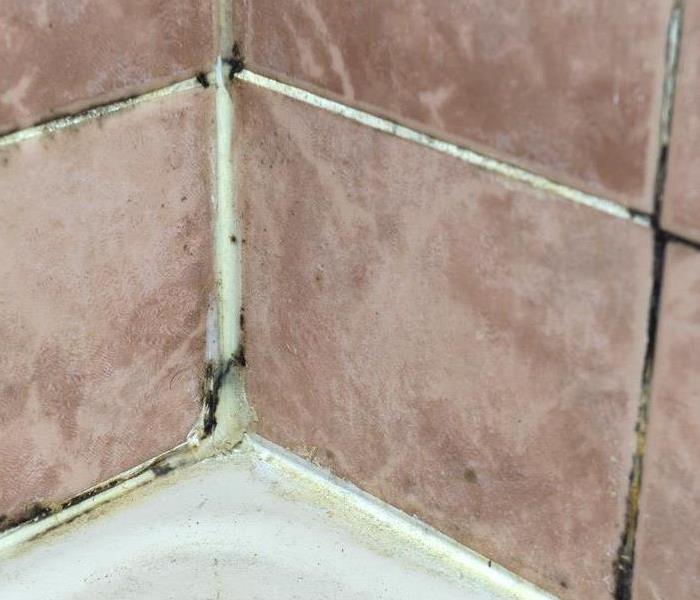 Cleaning your shower periodically to reduce mold and mildew damage.
Cleaning your shower periodically to reduce mold and mildew damage.
Dealing with mold in your shower can be a frustrating and unsightly problem. However, with the right approach and cleaning techniques, you can effectively eliminate mold and prevent its recurrence. In this blog, we will share some helpful tips on how to get rid of mold in your shower without addressing any health concerns or risks associated with mold exposure.
Gather the Necessary Supplies
Before starting the cleaning process, gather the essential supplies. You will need gloves, a mask, a scrub brush or sponge, a cleaning agent (such as vinegar, hydrogen peroxide, or a mold-specific cleaner), and hot water. Ensure the area is well-ventilated by opening a window or turning on a bathroom fan.
Remove Surface Mold
Start by removing any loose mold on the surface of your shower tiles or grout. Thoroughly scrub the affected areas with a brush or sponge. If using a cleaning agent, follow the instructions on the product label and apply it to the mold-infested surfaces. Rinse the area with hot water and allow it to dry completely.
Deep Clean the Grout
To tackle mold in grout lines, create a paste using baking soda and water. Apply the paste to the grout and scrub it using a toothbrush or small brush. This will help eliminate mold embedded in the porous grout. Rinse the grout lines thoroughly with hot water and wipe away any excess paste or residue.
Prevent Future Growth
To prevent mold from returning, it's essential to keep your shower clean and dry. After each use, wipe down the walls and tiles with a squeegee or towel to remove excess moisture. Periodically inspect the shower for any signs of mold and address the issue promptly to prevent it from spreading.
Regular Maintenance
Maintaining a clean shower is key to preventing mold growth in the long run. Regularly clean your shower using mildew-resistant cleaners to minimize mold and mildew buildup. Additionally, consider applying grout sealant periodically to create a protective barrier against moisture and mold.
Eliminating mold in your shower is manageable with the proper cleaning techniques. By following these tips, you can effectively tackle mold growth and maintain a clean and mold-free shower. Remember to prioritize regular maintenance and keep the shower area dry to prevent mold from reappearing in the future. In some cases, despite your best efforts, mold in the shower may persist or reoccur. If you find that the mold problem is extensive or difficult to remove on your own, it may be necessary to seek professional assistance. Professional mold remediation services have the expertise and specialized equipment to handle severe mold infestations safely and effectively. Remember to address mold issues promptly to ensure a clean and healthy shower environment for you and your family.
Tips to Protecting Your Remote-Based Business
10/17/2023 (Permalink)
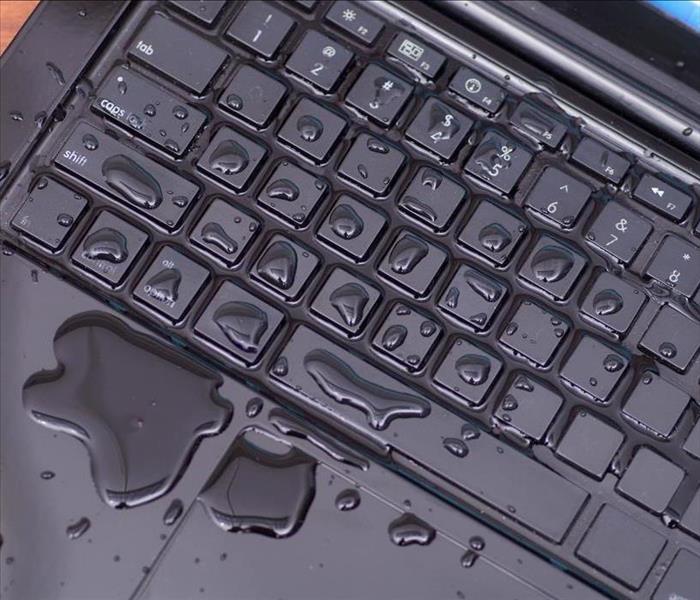 In this blog we provide some steps you can take to prepare for water damage and mitigate its impact on your work-from-home business.
In this blog we provide some steps you can take to prepare for water damage and mitigate its impact on your work-from-home business.
As the number of work-from-home businesses continues to grow, it's important to consider water damage preparedness. Water damage can cause significant disruption to a home-based business, resulting in property damage, loss of inventory, and loss of income. In this blog post, we will discuss some steps you can take to prepare for water damage and mitigate its impact on your home-based business.
Conduct Regular Risk Assessment
One of the first steps in water damage preparedness is to identify the risks that may affect your business. Conducting a risk assessment can help you identify potential sources of water damage, such as leaking pipes, poor drainage, and natural disasters. Make a list of these risks and prioritize them based on their likelihood and potential impact.
Regularly Inspect Your Property
Regular property inspections can help detect issues early, reducing the risk of significant water damage. Inspect your property regularly for signs of water damage, such as leaks, water stains, and mold growth. Address any issues promptly to prevent further damage.
Back up all your important business documents, files, and data regularly. This will reduce the risk of losing valuable information in case of water damage. Use cloud-based storage or an external hard drive to store your important files.
Consider Business Interruption Insurance
Business interruption insurance can help cover the loss of income and expenses suffered due to water damage. Consider purchasing this insurance to protect your business in case of significant damage.
Create a Water Damage Emergency Plan
Develop a plan of action to follow in case of water damage. This plan should include steps to take in case of an emergency, contact information for emergency responders, and a plan for evacuating important equipment and inventory.
Investing in flood preparedness equipment such as sandbags, flood barriers, and sump pumps can help minimize the impact of water damage. Determine which equipment will best suit your business's needs and ensure it is readily available.
Contact Professional Water Damage Restoration Services
In case of significant water damage, it's crucial to contact professional water damage restoration services. They have specialized equipment and expertise to assess the damage, mitigate further damage, and restore your property promptly.
In conclusion, water damage can cause significant disruption to work-from-home businesses, but with preparedness and proactive measures, you can protect your business from potential financial losses and significant damages. Conducting regular assessments, and inspections, and investing in flood preparedness equipment can minimize the risk of water damage. Always keep in mind that prompt response and professional help in case of significant water damage can help mitigate further damage and save your business.
Battling Mold After A Storm
9/16/2023 (Permalink)
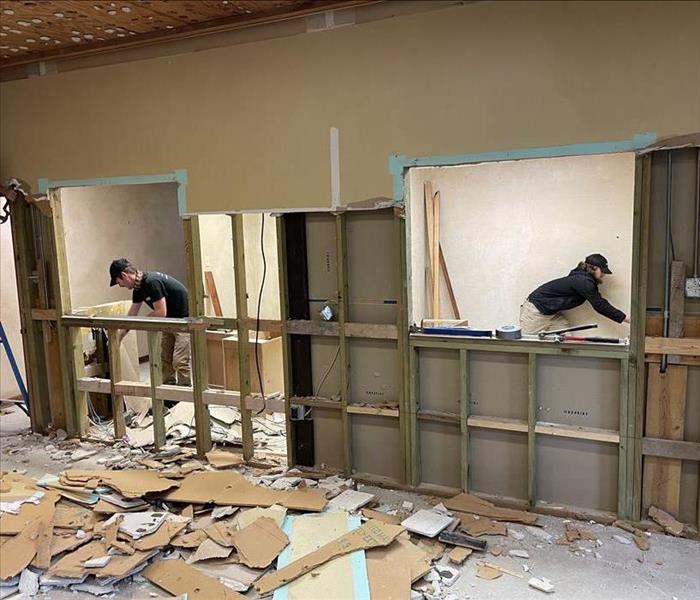 Mold growth is a common issue following water damage.
Mold growth is a common issue following water damage.
When the skies clear after a storm or flooding in Baton Rouge, the immediate concerns may seem to fade away. However, the aftermath often leaves a hidden threat that can affect your home: mold. Mold growth is a common issue following water damage, and it's crucial for Baton Rouge homeowners to understand the risks and take proactive steps to address mold remediation. In this guide, we'll walk you through the process of mold remediation after storms and flooding, helping you safeguard your property and restore a healthy living environment.
Recognizing the Signs of Mold Infestation
Mold is a type of fungus that thrives in damp, humid environments. After a storm or flooding, your Baton Rouge home could become a breeding ground for mold if not properly addressed. Keep an eye out for the following signs that indicate mold may be present:
Musty Odor: A strong, musty smell is often a clear indication of mold growth. If you notice an unusual odor, investigate further.
Visible Mold: Mold can appear as discolored patches on walls, ceilings, and other surfaces. Pay close attention to areas that were exposed to water during the storm.
Act Quickly: The Importance of Timely Mold Remediation
Addressing mold growth promptly is essential to prevent it from spreading and causing further damage. Mold spores can spread through the air and settle in other areas of your home, exacerbating the problem. Swift action is crucial to minimize the extent of the infestation.
DIY vs. Professional Mold Remediation
While minor mold issues can sometimes be addressed with DIY methods, larger infestations require professional intervention. In Baton Rouge, where humidity levels are often high, it's best to consult a certified mold remediation specialist who understands the local climate and mold behavior. Professionals have the expertise, equipment, and protective gear needed to safely remove mold and prevent its return.
The Mold Remediation Process
A comprehensive mold remediation process typically includes the following steps:
Assessment: A mold remediation expert will assess the extent of the infestation and identify the source of moisture that led to its growth.
Containment: To prevent mold spores from spreading to unaffected areas, the contaminated area is sealed off using specialized barriers and negative air pressure.
Removal: Affected materials, such as drywall and insulation, are safely removed and disposed of. This step may involve HEPA vacuuming and thorough cleaning.
Dehumidification: Drying the affected area is crucial to prevent future mold growth. Dehumidifiers and proper ventilation help reduce moisture levels.
Prevention: Mold thrives in damp environments, so controlling humidity levels is key to preventing future infestations. Proper ventilation and sealing leaks will help keep mold at bay.
Tips for Preventing Future Mold Growth
After the mold has been successfully remediated, it's important to take steps to prevent its return:
Monitor Humidity: Use a hygrometer to measure indoor humidity levels and keep them between 30-50%. Consider using dehumidifiers in areas prone to moisture.
Prompt Repairs: Address any leaks or water damage promptly to prevent mold-friendly conditions from developing.
Proper Ventilation: Ensure proper ventilation in high-moisture areas such as bathrooms, kitchens, and basements.
Regular Inspections: Conduct routine inspections to catch any potential mold issues early before they become major problems.
Landscaping and Grading: Properly direct rainwater away from your home's foundation by maintaining proper landscaping and grading.
Mold remediation after storms and flooding is a critical aspect of maintaining a safe home environment in Baton Rouge. By understanding the signs of mold infestation, acting swiftly, and enlisting the help of professionals when necessary, you can effectively combat mold growth and protect your property. Remember, prevention is key, so implement the recommended tips to ensure your home remains mold-free for years to come. Your dedication to mold prevention will contribute to the well-being of your family and the longevity of your Baton Rouge home.
How Emergency Board Up Services Can Save Your Property
9/12/2023 (Permalink)
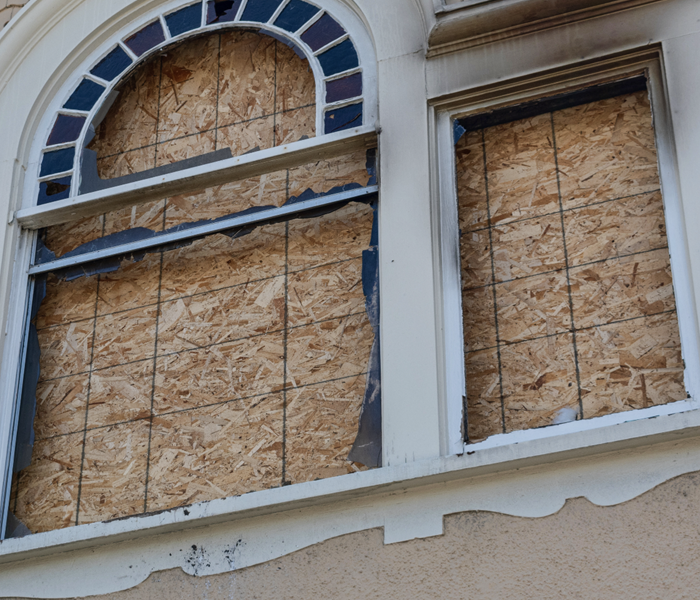 When disaster strikes, board up services help prevent your property from additional damages.
When disaster strikes, board up services help prevent your property from additional damages.
In times of disaster, such as severe storms, fires, or break-ins, your property may be exposed to various risks, including further damage, theft, or unauthorized entry. This is where emergency board up services come into play. These services offer a crucial solution to protect your property from additional harm and secure it until proper repairs can be made. In this blog post, we will explore the importance of emergency board up services and how they can save your property when disaster strikes. By understanding the benefits of this proactive measure, you can take swift action to safeguard your home or business in times of crisis.
Immediate Protection from Further Damage
When disaster strikes, your property may be left vulnerable to additional destruction. Broken windows, damaged doors, or compromised structural elements can expose your property to the elements, pests, and intruders. Emergency board up services provide an immediate solution by securing these openings, preventing further damage from weather, debris, or potential criminal activities.
Enhanced Security against Unauthorized Entry
An unsecured property is an invitation for theft, vandalism, or unauthorized entry. Emergency board up services effectively deter potential intruders by barricading access points and reinforcing weak areas. By installing sturdy boards or protective coverings, these services create a visible barrier, deterring opportunistic criminals and minimizing the risk of theft or vandalism.
Mitigation of Water and Weather Damage
Natural disasters often bring harsh weather conditions, such as heavy rains or high winds, which can lead to water damage and subsequent mold growth. Emergency board up services play a vital role in minimizing the exposure of your property to these elements. By sealing off broken windows, damaged roofs, or compromised entry points, these services can significantly reduce the risk of water intrusion, protecting your property from extensive water damage and associated issues.
Preservation of Personal Belongings
Your property is not just a structure; it holds your valuable possessions and cherished memories. Emergency board up services help preserve your belongings by creating a secure environment during a crisis. By safeguarding your property against potential looting or further damage, these services give you peace of mind that your personal items are protected until repairs can be made.
Insurance Compliance and Claims Assistance
In many cases, insurance policies require property owners to take immediate action to mitigate damage after a disaster. Failure to do so may result in denied or reduced insurance claims. Emergency board up services can assist you in complying with these requirements by providing documentation and proof of the steps taken to secure your property. This documentation can strengthen your insurance claims, ensuring a smoother and more efficient process.
When disaster strikes, every moment counts in protecting your property from further harm and securing your valuable assets. Emergency board up services offer a vital solution by promptly fortifying your property, preventing additional damage, and deterring unauthorized entry. By engaging these services, you can mitigate risks, preserve your belongings, and ensure compliance with insurance requirements. Remember, proactive measures are key to safeguarding your property in times of crisis. Take action, prioritize the security of your home or business, and partner with trusted emergency board up services to protect what matters most.
A Step-by-Step Guide: What to Do If Your Refrigerator Leaks
7/14/2023 (Permalink)
Discovering a leak from your refrigerator can be a cause for concern. Not only can it lead to water damage in your kitchen or surrounding areas, but it can also indicate an underlying issue that needs to be addressed promptly. In this blog post, we will provide you with a step-by-step guide on what to do if your refrigerator leaks. By following these steps, you can mitigate the damage, ensure the safety of your home, and potentially avoid costly repairs.
Safety First
When you notice a refrigerator leak, it's crucial to prioritize safety. Turn off the power supply to the refrigerator by unplugging it from the electrical outlet. This step will prevent any potential electrical hazards and reduce the risk of injury.
Locate the Source of the Leak
Identifying the source of the leak is the next important step. Start by inspecting the area around the refrigerator to determine the origin of the water. Common sources of leaks include:
Water supply line: If your refrigerator has a water dispenser or ice maker, check the water supply line connections at the back of the refrigerator for any signs of leakage or disconnection.
Defrost drain line: A clogged or damaged defrost drain line can cause water to accumulate and leak from the refrigerator. Check for any blockages or obstructions in the drain line.
Condensation: In humid climates or during hot weather, condensation can form on the exterior of the refrigerator and drip onto the floor. Ensure the leak is not simply condensation before proceeding with further steps.
Clear Blockages or Obstructions
If the leak is originating from the defrost drain line, it may be due to a blockage. Use a turkey baster or a small funnel to flush warm water through the drain line, clearing any debris or ice buildup that may be causing the blockage. This step can help restore proper drainage and prevent future leaks.
Check and Tighten Connections
If the leak is originating from the water supply line, inspect the connections at the back of the refrigerator and the water source. Ensure that all connections are secure and tightened properly. If you notice any damaged or worn-out parts, such as cracked or kinked water supply lines, they may need to be replaced.
Clean and Dry the Area
Once you have addressed the source of the leak, clean up any water that has accumulated around the refrigerator. Use absorbent towels or a mop to soak up the water and ensure the area is thoroughly dried. This step is crucial in preventing further water damage and the growth of mold or mildew.
Monitor for Recurring Leaks
After completing the necessary steps, keep an eye on your refrigerator to ensure that the leak has been resolved. If the leak persists or recurs, it may be an indication of a more significant issue. In such cases, it is recommended to contact a professional appliance repair service to diagnose and address the problem.
Discovering a leak from your refrigerator can be a cause for concern, but by following these steps, you can effectively address the issue and prevent further damage. Remember to prioritize safety, identify the source of the leak, clear any blockages, and check and tighten connections. Clean and dry the area thoroughly, and monitor for recurring leaks. If you're unable to resolve the issue on your own, don't hesitate to seek the assistance of a professional appliance repair service. By taking swift action, you can safeguard your home, protect your belongings, and ensure the proper functioning of your refrigerator.
Storm Damage Doesn't Always Involve Rain Flooding: Understanding Other Types of Storm-Related Hazards
6/15/2023 (Permalink)
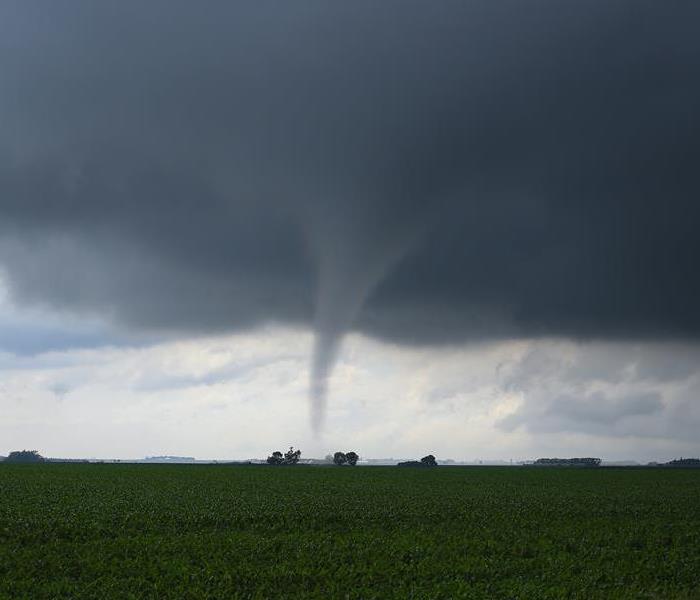 Being aware of storm damage that can occur after a natural disaster such as a tornado, high winds, or lightning strikes.
Being aware of storm damage that can occur after a natural disaster such as a tornado, high winds, or lightning strikes.
When we think of storm damage, our minds often envision torrential rain causing flooding and water damage. While this is indeed a significant concern during storms, it's important to recognize that storm damage can take many other forms as well. From high winds and falling trees to lightning strikes and hailstorms, storms can pose a range of hazards that can wreak havoc on properties. In this blog, we will explore the various types of storm damage beyond rain flooding, helping you better understand and prepare for the potential risks associated with severe weather.
High Winds
One of the most common and destructive aspects of storms is strong winds. These gusts can cause a wide range of damages, including:
- Roof Damage: High winds can lift and dislodge roof shingles, leading to leaks and structural vulnerabilities.
- Siding and Window Damage: Windborne debris can cause cracks, breaks, or even complete detachment of siding and windows.
- Falling Trees and Branches: Powerful winds can uproot trees or break branches, causing significant damage to buildings and surrounding structures.
Lightning Strikes
Lightning during storms can result in severe damage, including:
- Fire Hazards: Lightning strikes can cause fires, leading to devastating property damage.
- Electrical Surges: Power surges resulting from lightning strikes can damage electrical systems, appliances, and electronic devices.
- Hailstorms: Hail, a form of frozen precipitation, can cause substantial damage, such as:
- Roof Damage: Hailstones can puncture or dent roofs, leading to leaks and compromised structural integrity.
Exterior Damage
Siding, windows, and other exterior surfaces may suffer dents, cracks, or shattering due to hail impact after a storm. Vehicle damage from hailstorms can cause extensive damage to vehicles parked outdoors, including dented or shattered windshields and body panels.
Storm Surges
For properties located near coastal areas, storm surges pose a significant threat during hurricanes and tropical storms. These surges involve coastal flooding. In addition to rain flooding, storm surges can cause rapid and severe coastal flooding, leading to widespread property damage.
Tornadoes
In regions prone to tornadoes, these powerful vortexes can cause catastrophic damage, including complete destruction. Tornadoes can level buildings, leaving behind only debris. Tornadoes can cause structural damage and even weaker tornadoes can cause significant structural damage to roofs, walls, and foundations.
While rain flooding is often the primary concern during storms, it's crucial to be aware of the other types of storm damage that can occur. High winds, lightning strikes, hailstorms, storm surges, and tornadoes can all cause severe property damage and pose risks to occupants' safety. By understanding these different forms of storm damage, you can take appropriate measures to mitigate risks, such as reinforcing structures, securing outdoor items, and having emergency plans in place. Remember, comprehensive storm preparedness involves considering all potential hazards to ensure the safety and protection of your property and its occupants.
Mold Damage Tips: What to Do in an Emergency
5/15/2023 (Permalink)
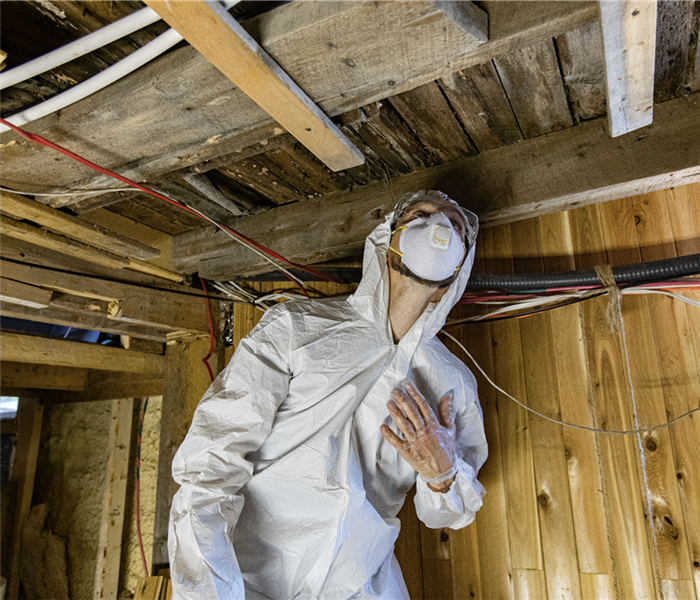 Mold damage is a serious problem that requires quick action to minimize the damage and prevent it from spreading.
Mold damage is a serious problem that requires quick action to minimize the damage and prevent it from spreading.
Mold damage is a serious problem that can cause extensive damage to your home and belongings. In addition to the physical damage, mold can also cause a musty odor that is difficult to remove. If you discover mold damage in your home, it's essential to take quick action to minimize the damage and prevent it from spreading. In this blog, we will discuss some tips on what to do in an emergency mold damage situation.
Stay Safe
When dealing with mold damage, it's important to stay safe and take necessary precautions. Wear appropriate personal protective equipment (PPE) such as gloves, goggles, and a respirator to prevent inhalation or contact with mold spores. Turn off the HVAC system to prevent the spread of mold spores and seal off the affected area to prevent the spores from spreading to other parts of the house. Be cautious when handling moldy materials, and avoid disturbing the mold to prevent further damage or spreading.
Identify the Source
Mold thrives in moist environments, so the first step in preventing mold damage is to identify the source of the moisture. Check for leaks or water damage in the affected area, and fix any problems as soon as possible. If you're unable to identify the source of the moisture, a professional restoration company, like SERVPRO of South Baton Rouge, can assist you in identifying and fixing the issue.
Dry the Affected Area
Once you've identified the source of the moisture, it's essential to dry the affected area as soon as possible. Mold can start to grow in as little as 24-48 hours, so it's important to act quickly. Use fans or a dehumidifier to dry the area, and if necessary, remove any standing water or wet materials. A professional restoration company has specialized equipment to dry and dehumidify the affected area thoroughly.
Clean the Affected Area
After the affected area is dry, it's essential to clean it thoroughly. Use a mixture of water and detergent to clean the affected area, and scrub any visible mold growth. It's important to remember that bleach is not an effective mold cleaner, and it can actually make the problem worse. A professional restoration company has specialized equipment and cleaning agents to remove mold thoroughly.
Dispose of Damaged Materials
If any materials are severely damaged by mold, such as drywall or carpeting, it's important to dispose of them properly. Do not attempt to remove or clean severely damaged materials, as this can spread mold spores and exacerbate the problem. A professional restoration company can safely remove and dispose of any damaged materials.
In conclusion, mold damage is a serious problem that requires quick action to minimize the damage and prevent it from spreading. If you discover mold damage in your home, it's important to stay safe, identify the source of the moisture, dry the affected area, clean it thoroughly, and dispose of any severely damaged materials. A professional restoration company like SERVPRO of South Baton Rouge has the expertise and specialized equipment to handle mold damage emergencies safely and effectively.



 24/7 Emergency Service
24/7 Emergency Service






